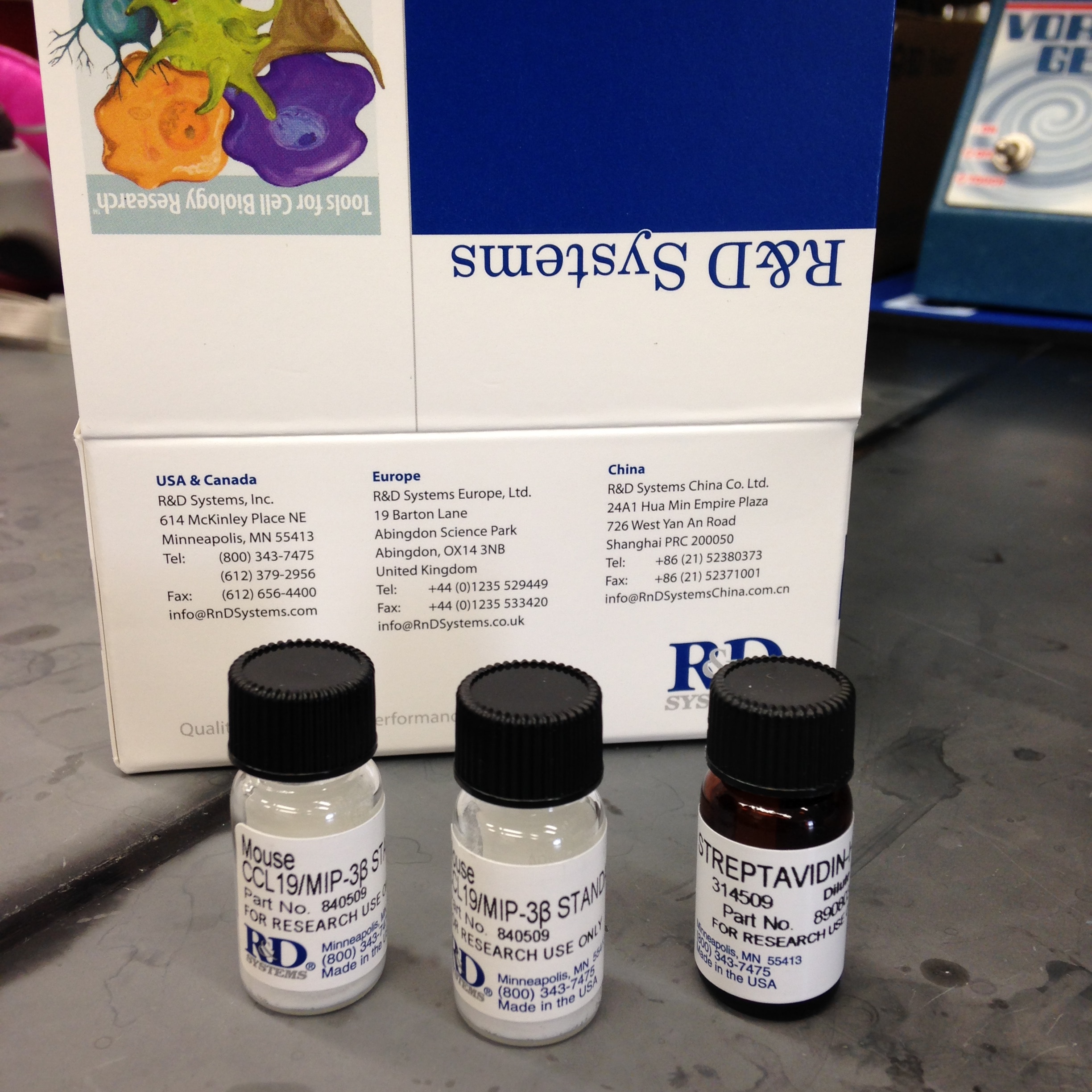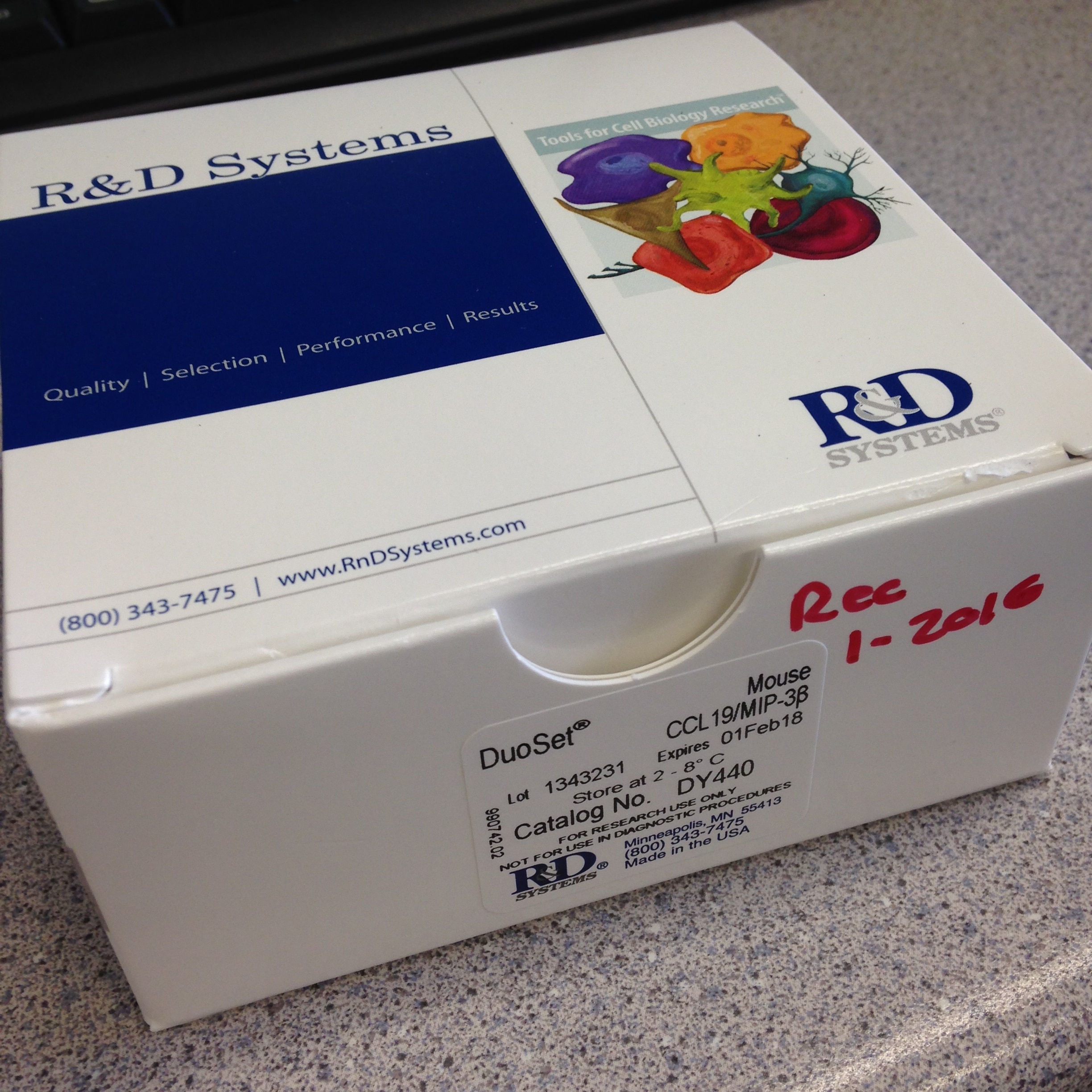Mouse CCL19/MIP-3 beta DuoSet ELISA Summary
* Provided that the recommended microplates, buffers, diluents, substrates and solutions are used, and the assay is run as summarized in the Assay Procedure provided.
This DuoSet ELISA Development kit contains the basic components required for the development of sandwich ELISAs to measure natural and recombinant mouse CCL19/MIP-3beta. The suggested diluent is suitable for the analysis of most cell culture supernate samples. Diluents for complex matrices, such as serum and plasma, should be evaluated prior to use in this DuoSet.
Product Features
- Optimized capture and detection antibody pairings with recommended concentrations save lengthy development time
- Development protocols are provided to guide further assay optimization
- Assay can be customized to your specific needs
- Economical alternative to complete kits
Kit Content
- Capture Antibody
- Detection Antibody
- Recombinant Standard
- Streptavidin conjugated to horseradish-peroxidase (Streptavidin-HRP)
Other Reagents Required
DuoSet Ancillary Reagent Kit 2 (5 plates): (Catalog # DY008) containing 96 well microplates, plate sealers, substrate solution, stop solution, plate coating buffer (PBS), wash buffer, and Reagent Diluent Concentrate 2.
The components listed above may be purchased separately:
PBS: (Catalog # DY006), or 137 mM NaCl, 2.7 mM KCl, 8.1 mM Na2HPO4, 1.5 mM KH2PO4, pH 7.2 - 7.4, 0.2 µm filtered
Wash Buffer: (Catalog # WA126), or 0.05% Tween® 20 in PBS, pH 7.2-7.4
Reagent Diluent: (Catalog # DY995), or 1% BSA in PBS, pH 7.2-7.4, 0.2 µm filtered
Substrate Solution: 1:1 mixture of Color Reagent A (H2O2) and Color Reagent B (Tetramethylbenzidine) (Catalog # DY999)
Stop Solution: 2 N H2SO4 (Catalog # DY994)
Microplates: R&D Systems (Catalog # DY990)
Plate Sealers: ELISA Plate Sealers (Catalog # DY992)
Scientific Data
Product Datasheets
Preparation and Storage
Background: CCL19/MIP-3 beta
Macrophage inflammatory protein 3 beta (MIP-3 beta), also known as ELC (EBI1-ligand chemokine) and exodus-3, is constitutively expressed in various lymphoid tissues, including thymus, lymph nodes, appendix and spleen. It is distantly related to other CC chemokines (20-30% amino acid sequence identity).
Assay Procedure
GENERAL ELISA PROTOCOL
Plate Preparation
- Dilute the Capture Antibody to the working concentration in PBS without carrier protein. Immediately coat a 96-well microplate with 100 μL per well of the diluted Capture Antibody. Seal the plate and incubate overnight at room temperature.
- Aspirate each well and wash with Wash Buffer, repeating the process two times for a total of three washes. Wash by filling each well with Wash Buffer (400 μL) using a squirt bottle, manifold dispenser, or autowasher. Complete removal of liquid at each step is essential for good performance. After the last wash, remove any remaining Wash Buffer by aspirating or by inverting the plate and blotting it against clean paper towels.
- Block plates by adding 300 μL Reagent Diluent to each well. Incubate at room temperature for a minimum of 1 hour.
- Repeat the aspiration/wash as in step 2. The plates are now ready for sample addition.
Assay Procedure
- Add 100 μL of sample or standards in Reagent Diluent, or an appropriate diluent, per well. Cover with an adhesive strip and incubate 2 hours at room temperature.
- Repeat the aspiration/wash as in step 2 of Plate Preparation.
- Add 100 μL of the Detection Antibody, diluted in Reagent Diluent, to each well. Cover with a new adhesive strip and incubate 2 hours at room temperature.
- Repeat the aspiration/wash as in step 2 of Plate Preparation.
- Add 100 μL of the working dilution of Streptavidin-HRP to each well. Cover the plate and incubate for 20 minutes at room temperature. Avoid placing the plate in direct light.
- Repeat the aspiration/wash as in step 2.
- Add 100 μL of Substrate Solution to each well. Incubate for 20 minutes at room temperature. Avoid placing the plate in direct light.
- Add 50 μL of Stop Solution to each well. Gently tap the plate to ensure thorough mixing.
- Determine the optical density of each well immediately, using a microplate reader set to 450 nm. If wavelength correction is available, set to 540 nm or 570 nm. If wavelength correction is not available, subtract readings at 540 nm or 570 nm from the readings at 450 nm. This subtraction will correct for optical imperfections in the plate. Readings made directly at 450 nm without correction may be higher and less accurate.
Citations for Mouse CCL19/MIP-3 beta DuoSet ELISA
R&D Systems personnel manually curate a database that contains references using R&D Systems products. The data collected includes not only links to publications in PubMed, but also provides information about sample types, species, and experimental conditions.
14
Citations: Showing 1 - 10
Filter your results:
Filter by:
-
Naringenin Attenuates Experimental Autoimmune Encephalomyelitis by Protecting the Intact of Blood-Brain Barrier and Controlling Inflammatory Cell Migration
Authors: X Niu, H Sang, J Wang
J Nutr Biochem, 2020-11-26;0(0):108560.
Species: Mouse
Sample Types: Plasma
-
Cytotoxic chemotherapy reduces T cell trafficking to the spleen by downregulating the expression of C-C motif chemokine ligand 21 and C-C motif chemokine ligand 19
Authors: L Liu, L Zhao, Y Yang, J Gao, C Hu, B Guo, B Zhu
Oncol Lett, 2018-08-09;16(4):5013-5019.
Species: Mouse
Sample Types: Tissue Homogenates
-
IL-7 and CCL19 expression in CAR-T cells improves immune cell infiltration and CAR-T cell survival in the tumor
Authors: K Adachi, Y Kano, T Nagai, N Okuyama, Y Sakoda, K Tamada
Nat. Biotechnol., 2018-03-05;0(0):.
Species: Mouse
Sample Types: Cell Culture Supernates
-
Expression of the B cell differentiation factor BAFF and chemokine CXCL13 in a murine model of Respiratory Syncytial Virus infection
Authors: W Alturaiki, AJ McFarlane, K Rose, R Corkhill, PS McNamara, J Schwarze, BF Flanagan
Cytokine, 2018-02-01;0(0):.
Species: Mouse
Sample Types: Tissue Homogenates
-
Deletion of the Chemokine Binding Protein Gene from the Parapoxvirus Orf Virus Reduces Virulence and Pathogenesis in Sheep
Authors: SB Fleming, C McCaughan, Z Lateef, A Dunn, LM Wise, NC Real, AA Mercer
Front Microbiol, 2017-01-24;8(0):46.
Species: Mouse
Sample Types: Protein
-
Immunization with HSV-2 gB-CCL19 Fusion Constructs Protects Mice against Lethal Vaginal Challenge.
Authors: Yan Y, Hu K, Deng X, Guan X, Luo S, Tong L, Du T, Fu M, Zhang M, Liu Y, Hu Q
J Immunol, 2015-05-20;195(1):329-38.
Species: Mouse
Sample Types: Cell Culture Supernates
-
De novo-induced self-antigen-specific Foxp3+ regulatory T cells impair the accumulation of inflammatory dendritic cells in draining lymph nodes.
Authors: Alissafi T, Hatzioannou A, Ioannou M, Sparwasser T, Grun J, Grutzkau A, Verginis P
J Immunol, 2015-05-06;194(12):5812-24.
Species: Mouse
Sample Types: Tissue Homogenates
-
CCRL1/ACKR4 is expressed in key thymic microenvironments but is dispensable for T lymphopoiesis at steady state in adult mice.
Authors: Lucas B, White A, Ulvmar M, Nibbs R, Sitnik K, Agace W, Jenkinson W, Anderson G, Rot A
Eur J Immunol, 2015-01-16;45(2):574-83.
Species: Mouse
Sample Types: Tissue Homogenates
-
The B lymphocyte differentiation factor (BAFF) is expressed in the airways of children with CF and in lungs of mice infected with Pseudomonas aeruginosa.
Authors: Neill, Daniel R, Saint, Gemma L, Bricio-Moreno, Laura, Fothergill, Joanne L, Southern, Kevin W, Winstanley, Craig, Christmas, Stephen, Slupsky, Joseph R, McNamara, Paul S, Kadioglu, Aras, Flanagan, Brian F
PLoS ONE, 2014-05-21;9(5):e95892.
Species: Mouse
Sample Types: Tissue Homogenates
-
A TNF-alpha-CCL20-CCR6 axis regulates Nod1-induced B cell responses.
Authors: Paradis M, Mindt B, Duerr C, Rojas O, Ng D, Boulianne B, McCarthy D, Yu M, Summers deLuca L, Ward L, Waldron J, Philpott D, Gommerman J, Fritz J
J Immunol, 2014-02-17;192(6):2787-99.
Species: Mouse
Sample Types: Serum
-
Co-delivery of ccl19 gene enhances anti-caries DNA vaccine pCIA-P immunogenicity in mice by increasing dendritic cell migration to secondary lymphoid tissues.
Authors: Yan Y, Qi S, Su L, Xu Q, Fan M
Acta Pharmacol Sin, 2013-01-21;34(3):432-40.
Species: Mouse
Sample Types: Cell Culture Supernates
-
CCR2 plays a critical role in dendritic cell maturation: possible role of CCL2 and NF-kappa B.
Authors: Jimenez F, Quinones MP, Martinez HG, Estrada CA, Clark K, Garavito E, Ibarra J, Melby PC, Ahuja SS
J. Immunol., 2010-04-19;184(10):5571-81.
Species: Mouse
Sample Types: Tissue Homogenates
-
CCR7 modulates pulmonary and lymph node inflammatory responses in cigarette smoke-exposed mice.
Authors: Demoor T, Bracke KR, Vermaelen KY, Dupont L, Joos GF, Brusselle GG
J. Immunol., 2009-12-15;183(12):8186-94.
Species: Mouse
Sample Types: BALF
-
Organizer-like reticular stromal cell layer common to adult secondary lymphoid organs.
Authors: Katakai T, Suto H, Sugai M, Gonda H, Togawa A, Suematsu S, Ebisuno Y, Katagiri K, Kinashi T, Shimizu A
J. Immunol., 2008-11-01;181(9):6189-200.
Species: Mouse
Sample Types: Cell Culture Supernates
FAQs
No product specific FAQs exist for this product, however you may
View all ELISA FAQsReviews for Mouse CCL19/MIP-3 beta DuoSet ELISA
Average Rating: 5 (Based on 2 Reviews)
Have you used Mouse CCL19/MIP-3 beta DuoSet ELISA?
Submit a review and receive an Amazon gift card.
$25/€18/£15/$25CAN/¥75 Yuan/¥2500 Yen for a review with an image
$10/€7/£6/$10 CAD/¥70 Yuan/¥1110 Yen for a review without an image
Filter by:




